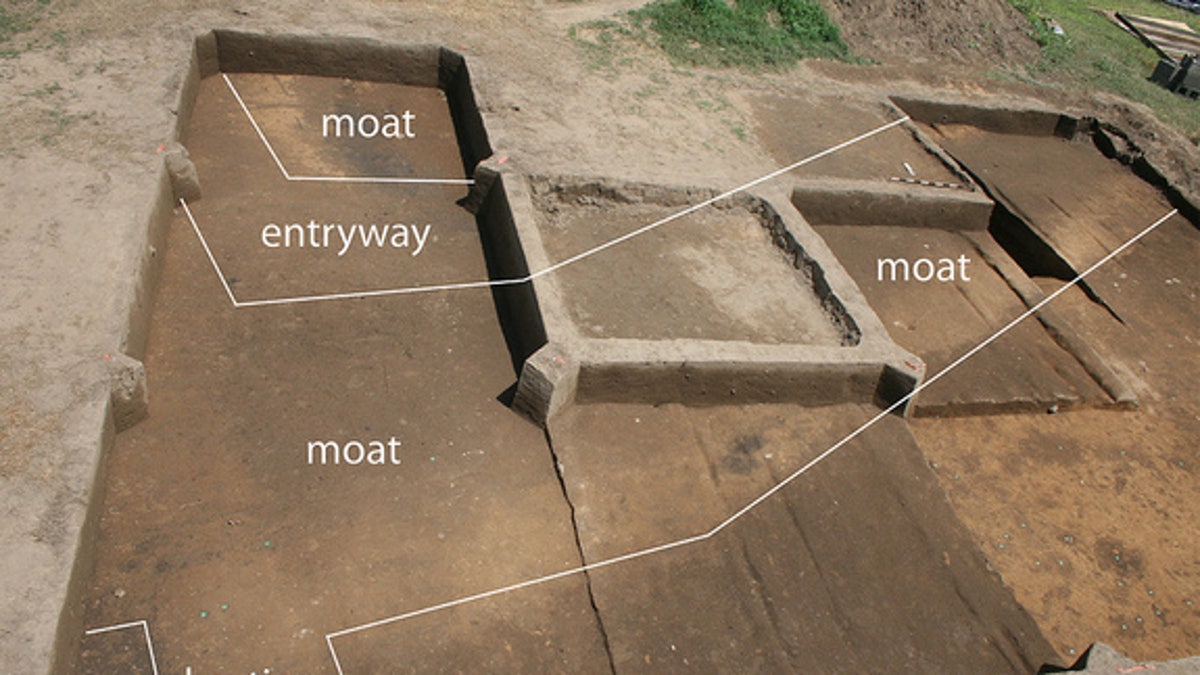
Researchers think food and sex contributed to the downfall of Fort San Juan, a Spanish garrison nearly 450 years old that was recently uncovered in North Carolina. This image shows the part of the fort that was revealed during excavations. (University of Michigan)
Before there was Jamestown and even before there was Roanoke, there was Spain's Fort San Juan, in the Appalachian foothills of North Carolina.
Archaeologists have uncovered the remains of the fort built by gold-hunting Spanish conquistadors in the 16th century and say it's the oldest European garrison ever found in the interior of the United States.
The settlement around Fort San Juan was occupied for less than two years and it met a rather bloody end likely brought on by the Spaniards' botched bartering for food and their sexual transgressions with Native American women. But the short-lived fort's traces serve as a reminder of how different U.S. history might have been if Spain had been more successful in its early colonial campaigns. [In Photos: Amazing Ruins of the Ancient World]
The garrison was built by Spanish Captain Juan Pardo and his men in about 1567 near what is today Morganton in western North Carolina, about 300 miles inland. It is thought to be the first and the largest of the forts that Pardo established in an attempt to colonize the American South. It's also the only one to have been discovered so far.
"Fort San Juan and six others that together stretched from coastal South Carolina into eastern Tennessee were occupied for less than 18 months before the Native Americans destroyed them, killing all but one of the Spanish soldiers who manned the garrisons," University of Michigan archaeologist Robin Beck said in a statement.
- Lost medieval mansion found at UK construction site
- Mayan discovery: Ancient monument reveals royal struggle
- Stone coffin to be opened at Richard III grave site
- Relics From King Richard II’s Tomb
- Walk in the footsteps of Jesus and other ways to bring the past to life
- Archaeologists say they uncovered King David’s Palace
The fort was located at the Native American site of Joara, part of the mound-building Mississippian culture. Previous excavations had revealed evidence of a European presence at Joara, including houses occupied by Spanish soldiers.
"We have known for more than a decade where the Spanish soldiers were living," another excavator, Christopher Rodning of Tulane University, explained in a statement. This summer, the team returned to learn more about the Mississippian mound at the site, but last month, their excavations inadvertently exposed part of the fort.
"For all of us, it was an incredible moment," Rodning said.
In addition to excavations, the researchers used techniques like magnetometry to probe the site. This allowed them to detect features buried below the surface, including the fort's V-shaped moat and a graveled entryway. Among the artifacts found at the site were nails, tacks, pottery and an iron clothing hook for fastening a jacket or attaching a sword scabbard to a belt, the researchers say.
The Spaniards were actively prospecting for gold while they occupied the site, though they never found the gold mines that would make North Carolina's settlers of the early 1800s rich. Archaeologists believe the colonizers' downfall was brought on by their own presumptions about how to trade with the Native Americans.
"The soldiers believed that when their gifts were accepted, it meant that the native people were their subjects," Beck said in a statement. "But to the natives, it was simply an exchange. When the soldiers ran out of gifts, they expected the natives to keep on feeding them. By that time, they had also committed what Spanish documents refer to as 'indiscretions' with native women, which may have been another reason that native men decided they had to go. So food and sex were probably two of the main reasons for destroying Spanish settlements and forts."
England exploited Spain's failure when they established Jamestown in 1607, putting in motion the American frontier narrative that's in the history books today, another archaeologist, David Moore of Warren Wilson College, explained in a statement.
"For Native Americans, though, this was the beginning of a long-term and often tragic reshaping of their precolonial world," Moore added.
